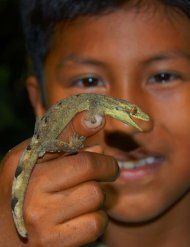You also want an ePaper? Increase the reach of your titles
YUMPU automatically turns print PDFs into web optimized ePapers that Google loves.
222<br />
APÉNDICE/APPENDIX 6<br />
ranchers, concentrated around a few small towns. In 1993, the<br />
regional population of people (2,441) was only slightly higher<br />
than the regional population of cattle (2,000), resulting in a<br />
human population density of roughly one and a half people per<br />
square kilometer. Population has risen rapidly since then, partly<br />
in response to the newly available land along the Interoceanic<br />
Highway and partly in the form of increased Colombian<br />
immigration due to Plan Colombia.<br />
The data also draw a dark picture of a region where<br />
basic amenities are often unavailable. Access to education,<br />
health care, clean water, electricity, and telephone service is<br />
uniformly poor, while the lack of adequate police and military<br />
protection means that living conditions close to the Colombian<br />
border and the nearby civil war are precarious. The majority of<br />
the residents in the region live by subsistence agriculture and<br />
dairy farming. Major crops in the higher elevations are corn and<br />
potatoes; at lower elevations these are replaced by beans,<br />
manioc, bananas, and other crops typical of the warm tropics.<br />
Fuentes and Aguirre (2001) estimate the amount of forest<br />
converted to date to these activities at roughly 15% of the<br />
landscape but increasing rapidly due to the increased access of<br />
the new highway.<br />
An important contribution of the socioeconomic report<br />
is an inventory of all past and current development projects in<br />
the region, a profile of active governmental and non-governmental<br />
groups, and a list of environmental impacts in the region. The<br />
authors also present a catalog of land tenure and use that shows<br />
what sort of colonization is taking place, and which land is<br />
claimed by whom. It is this kind of patient accumulation of detail<br />
on local political conditions that will lay the groundwork for a<br />
successful extension of the Cayambe-Coca’s boundaries.<br />
RECOMMENDATIONS<br />
On the basis of the biological and socioeconomic data gathered<br />
in the field, the authors recommend that the majority of the<br />
area be afforded protected area status. They stress that doing so<br />
successfully will require careful coordination with local inhabitants<br />
and sensible management and zonification. Working from<br />
their geographical database of vegetation, land tenure, and land<br />
use, they suggest that 77% of the buffer zone be set aside as a<br />
protected area to preserve a diversity of intact natural communities<br />
and add to the effectiveness of the Cayambe-Coca Ecological<br />
Reserve to the south.<br />
The remaining 23% of the region’s territory, mostly in<br />
the vicinity of La Sofía and La Bonita and along the Interoceanic<br />
Highway, would be a buffer zone for the new (or newly extended)<br />
protected area. Roughly half of this buffer zone corresponds to<br />
areas already cleared for fields and pastures, while the other half<br />
covers areas along the highway that are in the process of being<br />
colonized or are very likely to be colonized in the near future. In<br />
these areas residents would be free to continue small-scale agriculture<br />
and ranching, though with some additional assistance to<br />
improve quality of life and environmental sustainability.<br />
Fuentes and Aguirre (2001) weigh a variety of<br />
alternatives for the proposed protected area and conclude by<br />
recommending the establishment of a “Bosque Protector.” Their<br />
choice is framed by practical and political concerns. The authors<br />
admit that a northwards extension of the Cayambe-Coca Ecological<br />
Reserve would provide stronger legal protection to the region’s<br />
natural communities, but worry that it would be unpopular<br />
among the local residents and would further tax the reserve’s<br />
already overworked administration. We believe that these<br />
important concerns can be overcome. The first concern points to<br />
the important caveat that any extension should not come as a<br />
surprise to local inhabitants, but as part of a collaborative process<br />
that respects their long-term occupation of the area. The second<br />
is related to the first, in that the degree to which the new area<br />
will burden the administration of the ecological reserve depends<br />
on the degree to which local residents themselves can assume or<br />
assist management of the new protected area. Fuentes and<br />
Aguirre (2001) propose that a large part of the area be managed<br />
by the municipality of La Bonita. We strongly agree that this sort<br />
of local control—balanced by effective agreements with the<br />
Ministry of the Environment—will be necessary for long-term<br />
conservation success in the area.<br />
RAPID BIOLOGICAL INVENTORIES INFORME/REPORT NO.3

















